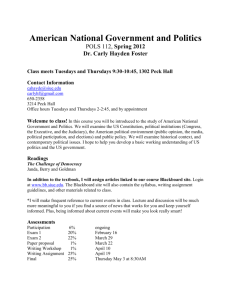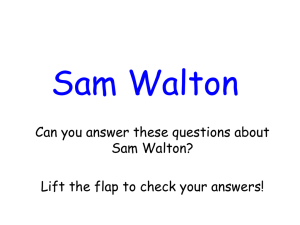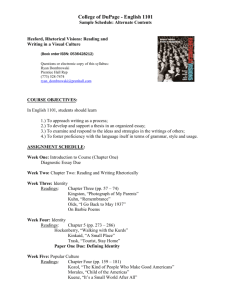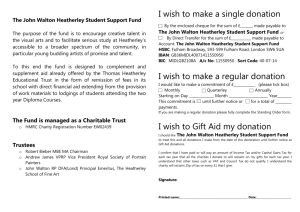Political Parties : 314
advertisement
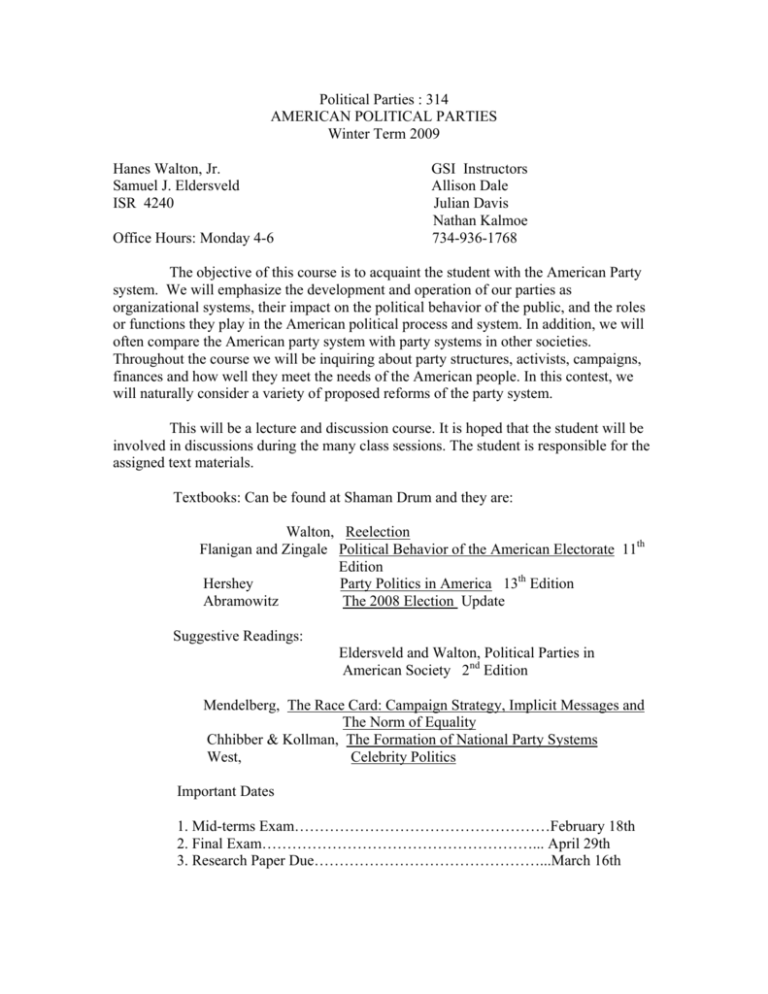
Political Parties : 314 AMERICAN POLITICAL PARTIES Winter Term 2009 Hanes Walton, Jr. Samuel J. Eldersveld ISR 4240 Office Hours: Monday 4-6 GSI Instructors Allison Dale Julian Davis Nathan Kalmoe 734-936-1768 The objective of this course is to acquaint the student with the American Party system. We will emphasize the development and operation of our parties as organizational systems, their impact on the political behavior of the public, and the roles or functions they play in the American political process and system. In addition, we will often compare the American party system with party systems in other societies. Throughout the course we will be inquiring about party structures, activists, campaigns, finances and how well they meet the needs of the American people. In this contest, we will naturally consider a variety of proposed reforms of the party system. This will be a lecture and discussion course. It is hoped that the student will be involved in discussions during the many class sessions. The student is responsible for the assigned text materials. Textbooks: Can be found at Shaman Drum and they are: Walton, Reelection Flanigan and Zingale Political Behavior of the American Electorate 11th Edition Hershey Party Politics in America 13th Edition Abramowitz The 2008 Election Update Suggestive Readings: Eldersveld and Walton, Political Parties in American Society 2nd Edition Mendelberg, The Race Card: Campaign Strategy, Implicit Messages and The Norm of Equality Chhibber & Kollman, The Formation of National Party Systems West, Celebrity Politics Important Dates 1. Mid-terms Exam……………………………………………February 18th 2. Final Exam………………………………………………... April 29th 3. Research Paper Due………………………………………...March 16th -2- Outline of Course: Topics and Readings Week 1 Political Parties in Society: What are their Functions and Roles Hershey Chapter 1 Walton, Chapter 1; Flanigan Chapter 1 Other Suggested Readings: Anthony Downs, An Economic Theory of Democracy pp. 24-31 V.O. Key, Jr. Southern Politics Chapter 15 Samuel DuBois Cook, “Introduction: The Politics of The Success of Failure,” in H. Walton, Jr., Black Political Parties T Mendelberg, The Race Card Chapter 1 Week 2 The U.S. Party System Viewed Comparatively: How Unique is Our System? Hershey Chapter 16 Eldersveld and Walton Chapter 2 Other Suggested Readings: Arend Lijphart, Russell Dalton, Democracies 1984, pp; 106-114. Citizen Politics: Public Opinion and Parties Chapter 7 G.B. Powell, “Party Systems and Political System Performance,” American Political Science Review vol. 75 (Dec, 1981). Chhibber & Kollman, “Party Aggregation and Number of Parties,” American Political Science Review (June, 1998), pp. 329-342. Week 3 The American Party System’s Origins: Why Did We Develop A Two-Party System? Hershey Chapter 1; Walton Chapter 2; Flanigan, Chapter 4 Other Suggested Readings: Richard Hofstadter, The Idea of a Party System Chapter 1 William Chambers, The First Party System pp. 45-56 John Aldrich, Why Parties? Chapter 2 -3Ted Brader and Joshua Tucker, “The Emergence of Mass Partisanship in Russia, 1993-1996,” American Journal of Political Science vol 45 (January, 2001), pp. 63-83. Donald Stokes and G.R. Iversen, “On the Existence of Forces Restoring Party Competition,” Public Opinion Quarterly vol. 26 (Summer, 1962). Seymour Lipset and Stein Rokkan, (eds.) Party Systems And Voter Alignments pp. 1-56. Week 4 Third Parties: What Chances Do They Have? Hershey Chapter 2: Rapoport & Stone, Three’s A Crowd Entire Book Other Suggested Readings: Walton, “African Americans, H. Ross Perot, and Image Politics: The Nature of African American Third Party Politics,” in Walton, African American Power and Politics: The Political Context Variable pp. 282-293 _________, Black Political Parties Chapter 5 and 6 Steven Rosenstone, Roy Behr and Richard Lazarus, Third Parties in America Chapter 3 Steven Rosenstone and John Hansen, Mobilization, Participation and Democracy in America pp. 188-210 Rodolfo O. de la Garza (eds) Awash in the Mainstream: Latino Politics in the 1996 Election Week 5 Our Presidential Nomination System: A New Model Hershey Chapter 9 Walton: Chapters 9 & 10; Flanigan Chapter 7 2008 Election Update Entire work Other Suggested Reading: Paul Abramson, et. al., Change and Continuity in the 2004 Elections Chapters 3 & 4 John Aldrich “A Dynamic Model of Presidential Nomination Campaigns,” APSR PP. 651-669 -4Week 6 Parties and Leadership Recruitment: How Important are the Parties? Hershey Chapter 10 Walton Chapters 6, 7 & 8 Other Suggested Readings: Sandy Maisel, et al., “The Naming of the Candidates: Recruitment or Emergence?” in The Parties Respond pp. 137159. Chong Lim Kim, et al, “Partisanship in the Recruitment and Reforms of American State Legislatures,” in Eulau and Czudnowski, Elite Recruitment Kenneth Prewitt, The Recruitment of Political Leaders Chapter 3 Aldrich, “Jacksonian Democracy,” Chapter 4 Week 7 The Public Support for the Parties: Is It Really Declining? Hershey Chapter 6 & 7; Walton, Chapter 12; Flanigan Chapter 3,4, 5, & 6 Other Suggested Readings: Dalton, Citizen Politics 4th Edition Chapter 9 Bruce Keith, et al The Myth of the Independent Voters Chapter 5, 10, & 2 Walter Devries and Lance Tarrance, The Ticket Splitters Warren Miller, “Party Identification, Realignment, and Party Voting: Back to the Basics,” APSR pp. 557-568. Angus Campbell, et al., The American Voter Chapter 5&6 David Mayhew, Electoral Realignments: A Critique of An American Genre pp. 1-47 Week 8 National Party Organizations: Stronger Than Ever? Hershey Chapter 4; Walton Chapter 12 -5Other Suggested Readings: Austin Ranney, Curing the Mischief’s of Faction pp. 22-57 Paul Herrnson, Party Campaigning in the 1980s Chapters 2 & 3 Shea and Green, The State of Parties 1994 The Politics of Cohesion: The Role of The National Party Committees in the 1992 Election” _____________, The State of Parties, 1994 “The Democratic Leadership Council: Institutionalizing Party Factions,” Week 9 State and Local Party Structures: How Effective are the Activists? Hershey Chapter 3 ; Walton Chapter 4 & 5 Other Suggested Readings: William Crotty, Political Parties in Local Areas Read the Chapters on Detroit, Chicago, Los Angeles, Houston, Nashville Raymond Wolfinger, “Why Political Machines Have Not Withered Away,” Journal of Politics (1972), pp. 365-398. Mike Royko, Boss: Richard J. Daley of Chicago Paul Frymer, “Is the Concept of Electoral Capture Applicable to Other Groups? The Case of Gay and Lesbian Voters in the Democratic Party and the Christian Right In the Republican Party” in Frymer pp. 179-206. John Frendeis, “Voters, Government Officials, and Party Organization,” Shea and Green, pp.147-162. -6Week 10 The Campaign Process: Are the New Strategies and Technologies Working? Hershey Chapters 11 & 5; Walton Chapter 10; Flanigan Chapter 6 Other Suggested Readings: Paul Herrnson Party Campaigns in the 1980s Chapter 4 Shanto Iyengar and Donald Kinder, News That Matters Larry Sabato, The Rise of Political Consultants: New Ways of Winning Elections Tali Mendelberg, The Race Card Chapter 5 Keith Reeves, Voting Hopes or Fears? Herbert Asher, Polling and the Public 5th Edition Kenneth Warren, In Defense of Public Opinion Polling Week 11 Money and Political Campaigns: Why the Rise of the 527s? Hershey Chapter 12 Other Suggested Readings: Anthony Corrado, Thomas Mann, and Trevor Potter (eds) Finance Battle: Court Testimony on the New Reforms Janet Grenzke, “Pacs and the Congressional Supermarket,” American Journal of Political Science vol 33 (1989), pp, 1-24. Darrell West, Checkbook Democracy: How Money Corrupts Political Campaigns Ross K. Baker, The New Fat Cats: Members of Congress -7- Week 12 Part I; Parties and the Election Process: Why is Turnout So Low? Hershey Chapter 8; Walton Chapter 2 & 3; Flanigan Chapter 2 Other Suggested Readings: Richard Brody, “The Puzzle of Participation In America” The New American System. Arend Lijpart, “Unequal Participation: Democracy’s Unresolved Dilemma,” APSR vol 91 (March, 1977). Rosenstone and Hansen, Mobilization, Participation and Democracy Chapters 5, 6, & 7. Week 12 Part II: Contested Presidential Elections: What is the Role of the Courts? Other Suggested Readings: Donald Stephenson, Jr. Campaign and the Courts: The United States Supreme Court in Presidential Elections Week 13 Parties and Governance: How Effective are Parties in Congress? Hershey Chapter 13 & 14 & 15 Other Suggested Readings: Gary Cox and Matthew McCubbins, Legislative Leviathan: Party Government in the House Chapters 5 & 10. David Rhode Parties and Leaders in the Post Reform House PP. 17-34. Green and Farmer, The State of Parties Chapters 14 & 15 & 19 Week 14 Parties and the Race Problem: Is it a Factor in Elections? Hershey Chapter 16 Walton Chapter 5 and Other Suggested Readings: -8Tasha Philpot, Race, Republicans, and the Return of the Party Of Lincoln Michael Fauntroy, Republicans and the Black Vote Paul Frymer, Uneasy Alliance: Race and Party Competition In America Ronald Walters, Freedom is Not Enough: Black Voters, Black Candidates and American Presidential Politics Edward Carmines and James Stimson, Issue Evolution: Race And the Transformation of American Politics pp. 27-58 Donald Kinder and Lynn Sanders, Divided by Color Chapter 5 & 6. Katherine Tate, From Protest to Politics: The New Black Voters In American Elections Chapters 7 & 8. Michael Dawson, Black Visions pp. 44-84

